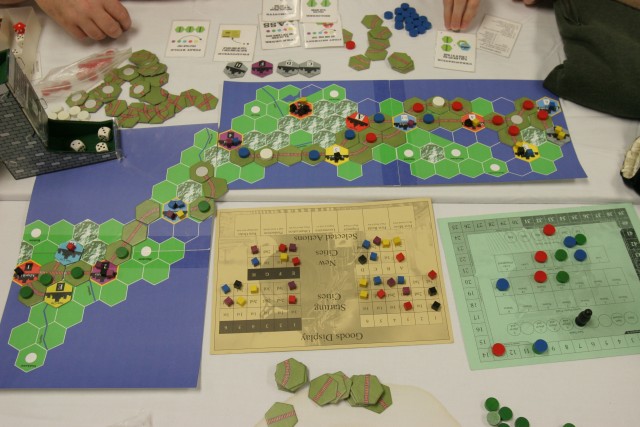
For the first game, Age of Steam looked like a likely candidate. Some one
had set it up and was willing to play. Little did I know that he has played
in a lot of tournaments and had designed this map. But I wanted to get more
AOS experience under my belt, so I was game to try it out.
This map introduces a couple of new features. The first is building over
water. This is more costly than over mountains (costs 6 dollars) and can
only be built over one water section. The second is water/land hexes. When
you build on these, there are two cases. If the next tile is land, then the
tile acts like a river, otherwise it acts like a water hex. The last new
feature is the engineer action is a temporary +1 link ability. This allows
you to deliver length 7 goods for one turn if you engine capacity is at six.
The map is very tight. I passed the first auction and built off by myself.
When the game was 2/3rds over, I finally broke even. Dakarp was probably
hurt by building next to rri1 (the designer). So, the game turned out into
a pretty obvious first (rri1 – ending in the 100s), second (me), and third
(dakarp).

Eggert Spiele’s new game is called Imperial. I have learned that the game has
been in development for years now and was actually the precursor to Antike.
People who have played Antike will recognize a lot of similiarity to Antike.
A roundel determines what action is performed. You can move three spaces
for free and optionally pay to move up to three more. The actions are as
follows:
-
Maneuver – move ships and armies. You can convoy armies across ships.
Armies and ships can occupy neutral territorys to gain income. Or they
can attack other country’s troops or factories. -
Investor – causes a payout to shareholders from the countries bank.
The investor marker moves around. - Import
- Production – All factories may produce their corresponding units.
- Taxation – generates income to the country’s bank and may give you money.
-
Factory – the country pays five million to create a factory (either an
army or naval factory).
What is different in this game is that you are an investor in countries.
If you own the most shares in a country, then you determine its actions
when the country’s turn comes up. Shares have a cost to purchase, a
percentage of interest that you receive when the investor action is taken,
and a victory point total. The score track on the board acts like Antike.
When one country reaches 25, then the game is over. This track is also
broken up into sections. These sections tell you what multiplier to use
against the corresponding country shares. It starts out with a x0 and goes
up to a x5 for the 25 spot. So if United Kingdom won and I had a 6 million
share in it, then my victory points would be 5×3 since that share has a 3
In the game, I was hosed early. I sent one fleet out into the Mediterranean
sea. I had wanted to use that ship to move my armies into Africa. However,
France decided to attack me and remove the ship instead of peacefully
coexisting. This forced me to then spend turns building up my armies
and attacking France back to get controll that I needed. This pissed off
France (the person playing it) because he was not in the lead and he
wanted my to attack the leader. I just needed to increase Italy’s presence
to get more money. Since having money allows you to buy shares in the
countries that are winning.
Still, it is a cool game and one that I will definately buy.

Mike checked this game out of the library because it is another new
Essen game where we had English rules for it. We only got to play a couple
of rounds for it since I needed to head off for dinner soon. The Texas Hold-Em
tournament would be immediately after dinner.
This game is like Thurn und Taxis. But the new thing that it brings to the
table is the process to determine which tiles you receive. On the lower left
section of the board is a grid. You can place pieces either on the numbered
circles or on top of the tiles. To place a piece, you pay the price in the
circle. If you go on top of a tile, you pay 2 dollars. After everyone has
placed all four of their pieces, we determine who receives the tiles. If a
tile is surrounded by more of your pieces than someone else’s (including being
on top of it), then you get it. Ties are broken by first being on top of the
tile, or second, having more pieces orthagonally touching the tile. After
all of the tiles have been resolved, then we determine payouts. For all of the
numbered rows and columns, a person gets the triangle point value in dollars.
The next phase is the placing of the tiles. Essentially, you move your
marker around the board while paying the cost on the paths. If you turn in
a tile for a city (which only takes one type of tile), then you place a house
down. And when an area is surrounded by houses, you get to put a marker in
the lower right section of the board. This section will give you victory
points.
In this game, poor Mike was alway hosed by me. I was sitting to his right.
And when I needed to commit my pieces to try and get certain tiles, it just
happened to be what Mike was going after. Sadly, due to the luck of the
draw for the tiles, there was really no other choice for me. I needed those
pieces for my path.
